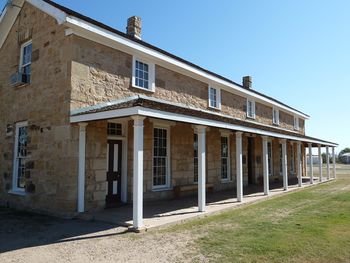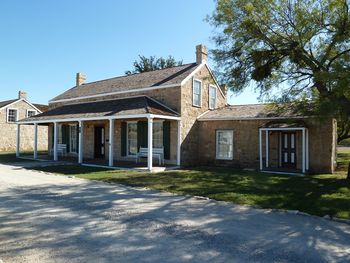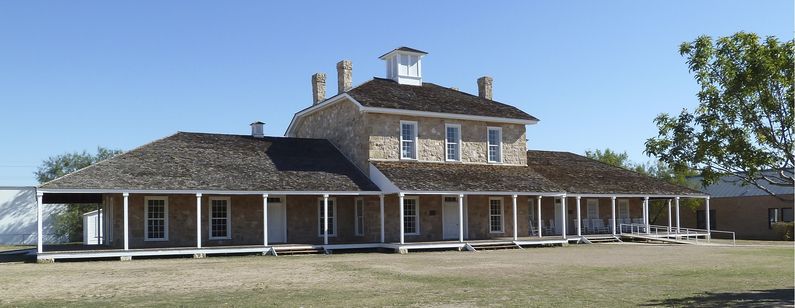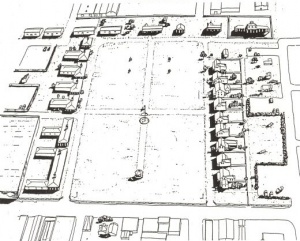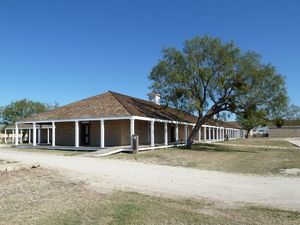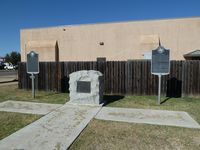Fort Concho
|
{SocialNetworks}} {Fort Concho (1867-1889) - The site was selected in November 1867 for a new post to replace Fort Chadbourne, which lacked an adequate water supply. Company H of the 4th U.S. Cavalry arrived there in Dec 1867. The post's first commanding officer, Captain George Gibson Huntt, named the post Camp Hatch after the commander of his regiment, Major John Porter Hatch (Cullum 1247). Later it was called Camp Kelly for the late Major Michael J. Kelly, and in March 1868 the post became Fort Concho, named after the Middle and North Concho rivers, which converge in San Angelo to form the Concho. HistoryIn 1868 Fort Concho's commissary storehouse (today the oldest building in San Angelo) and its twin, the quartermaster storehouse were constructed. Building materials had to be hauled from the Gulf Coast by ox cart. In 1876 an official report stated that "a flat, treeless, dreary prairie" surrounded the fort, but Captain Robert G. Carter (Cullum 2349) recalled Fort Concho in the 1870s as "one of the most beautiful and best-ordered posts on the Texas border. Its arrangement was artistic and every feature bespoke comfort and convenience. On the south side of the ample parade grounds stood the officers' quarters, tasty, elegant, imposing; on the north, the commodious and handsome barracks; on the east side the commissary and quartermaster's buildings, while the west side of the grounds was closed with an ornamental fence with a large gateway in the center." The government leased the land from private owners. The fort was not stockaded, but stone walls surrounded the hospital and the backyards of the officers' quarters. By 1879 Fort Concho was an eight-company post with some forty permanent structures built of locally quarried limestone around a parade ground that measured about 500 by 1,000 feet. Besides the buildings mentioned by Carter, the fort's stone buildings included stables, blacksmith and carpenter shops, a forage house, an ordnance storehouse, a guardhouse, a powder magazine, a pump house, a bakery, a hospital, an administration building, and a schoolhouse that was used also as a chapel. A number of temporary frame buildings-married soldiers' quarters, telegraph office, and post trader's store-were built adjacent to the fort. A belvedere on the post-hospital afforded a distant view in every direction. Commanders of Fort Concho included such famous officers as William R. Shafter, Ranald S. Mackenzie (Cullum 1967), Benjamin H. Grierson, John P. Hatch, and Wesley Merritt (Cullum 1868).
Units from Fort Concho scouted and mapped large portions of West Texas; built roads and telegraph lines; escorted stagecoaches, cattle drives, and railroad survey parties; and served generally as a police force. At times Fort Concho troops were stationed at semipermanent sub posts at Grierson's Spring, Camp Charlotte, and the head of the North Concho. Among the numerous temporary field camps were several former Butterfield Overland Mail stops such as Johnson's Station, Grape Creek Station, and old Fort Chadbourne. In the early years of the fort's existence, its soldiers skirmished with numerous small parties of Indians. Fort Concho also furnished personnel and supplies for three major Indian campaigns: Mackenzie's 1872 campaign, the 1874 Red River War, and the Victorio campaign of 1879-80. The army abandoned the fort on June 20, 1889.
Current StatusMust See! Today the fort contains 23 main structures, mostly original or restored, but some reconstructions. These structures include a Headquarters, Officers' Quarters, Soldiers' Barracks, and the Post Hospital. The fort was designated a National Historic Landmark in 1961.
See Also: Sources:
Links: Visited: 27 Apr 2015, 16 Nov 2011
| |||||||||||||||||||||||||||||||||||||||||||||||||||||||||||||||||||||||||||||||
